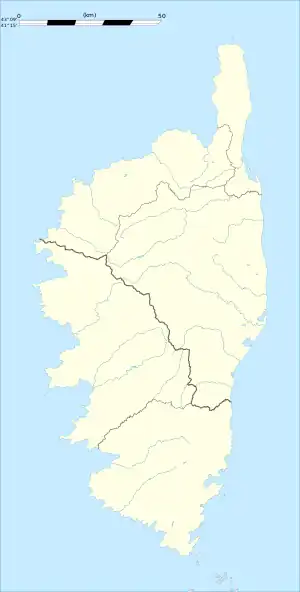Patrimonio
Patrimonio (Italian pronunciation: [patriˈmɔːnjo]; French: [patʁimɔnjo]; Corsican: Patrimoniu, [patriˈmɔnju]) is a commune in the French department of Upper Corsica, collectivity and island of Corsica.
Patrimonio | |
|---|---|
 The church and surrounding buildings in Patrimonio | |
.svg.png.webp) Coat of arms | |
Location of Patrimonio | |
 Patrimonio  Patrimonio | |
| Coordinates: 42°41′54″N 9°21′44″E | |
| Country | France |
| Region | Corsica |
| Department | Haute-Corse |
| Arrondissement | Calvi |
| Canton | Cap Corse |
| Government | |
| • Mayor (2020–2026) | José Poggioli[1] |
| Area 1 | 17.46 km2 (6.74 sq mi) |
| Population | 881 |
| • Density | 50/km2 (130/sq mi) |
| Demonym(s) | French: Patrimonien.ne Corsican: patrimunincu, patrimuninca Italian: patrimoniese |
| Time zone | UTC+01:00 (CET) |
| • Summer (DST) | UTC+02:00 (CEST) |
| INSEE/Postal code | 2B205 /20253 |
| Elevation | 0–1,025 m (0–3,363 ft) (avg. 100 m or 330 ft) |
| 1 French Land Register data, which excludes lakes, ponds, glaciers > 1 km2 (0.386 sq mi or 247 acres) and river estuaries. | |
The inhabitants are known as patrimoniens and patrimoniennes in French, patrimuninchi (singular: patrimunincu, patrimuninca) in Corsican, and patrimoniesi (singular: patrimoniese) in Italian.
Geography
Located 12 km from Bastia and 4 km from the micro-region of Saint-Florent, this wine-growing commune is the gateway to the Cap Corse (peninsula at the northernmost point of Corsica).
History
The village of Patrimonio is known for the quality of its AOC (quality-controlled designation of origin) wines and for its guitar nights. The festival lasts for a week.
Population
| Year | Pop. | ±% |
|---|---|---|
| 1962 | 345 | — |
| 1968 | 393 | +13.9% |
| 1975 | 397 | +1.0% |
| 1982 | 447 | +12.6% |
| 1990 | 546 | +22.1% |
| 1999 | 645 | +18.1% |
| 2008 | 666 | +3.3% |
Sights
- A menhir (or standing stone) found in a vine in 1964 by two labourers, the Gilormini brothers from Patrimonio. (The menhir is called "U Nativu".)
- St. Martin's Church (San Martinu)
- The small Santa Maria chapel
References
- "Répertoire national des élus: les maires". data.gouv.fr, Plateforme ouverte des données publiques françaises (in French). 2 December 2020.
- "Populations légales 2020". The National Institute of Statistics and Economic Studies. 29 December 2022.
External links
- Photos of the village
- Official site (in French) of the annual guitar festival (Les Nuits de la guitare de Patrimonio)
Wikimedia Commons has media related to Patrimonio (Haute-Corse).
This article is issued from Wikipedia. The text is licensed under Creative Commons - Attribution - Sharealike. Additional terms may apply for the media files.